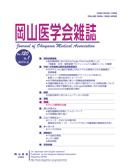

Journal of Okayama Medical Association
Published by Okayama Medical Association<Availability>
Full-text articles are available 3 years after publication.
Permalink : https://ousar.lib.okayama-u.ac.jp/15971
Mechanism of the dissolution of enflurane and isoflurane into human, dog and bovine blood
Tada, Keiichi
Published Date
1987-08-30
Abstract
This study was performed to elucidate the difference in the mechanism of the dissolution of enflurane and isoflurane into human, dog and bovine blood in terms of changes in the hematocrit using the highly accurate analytical method of direct gas chromatography. With enflurane, as the hematocrit increased, the blood-gas partition coefficient for human and bovine blood decreased linearly (P < 0.001), and that for dog blood increased linearly (P < 0.001). With isoflurane, as the hematocrit increased, the blood-gas partition coefficient for the blood of all three animals decreased linearly (P < 0.001). Enflurane has a stroger affinity for red cells than for plasma in dog blood, as indicated by positive linearlity, while the opposite is true in human and bovine blood, as indicated by negative linearlity. Isoflurane has a stronger affinity for plasma than for red cells as indicated by negative linearlity in human, dog and bovine blood. The characteristic value of the red cell/plasma partition coefficient was 2.92 for enflurane in dog blood, and 0.09 for isoflurane in human blood.
Keywords
血液/ガス分配係数
血球/血漿分配係数
enflurane
isoflurane
ISSN
0030-1558
NCID
AN00032489
